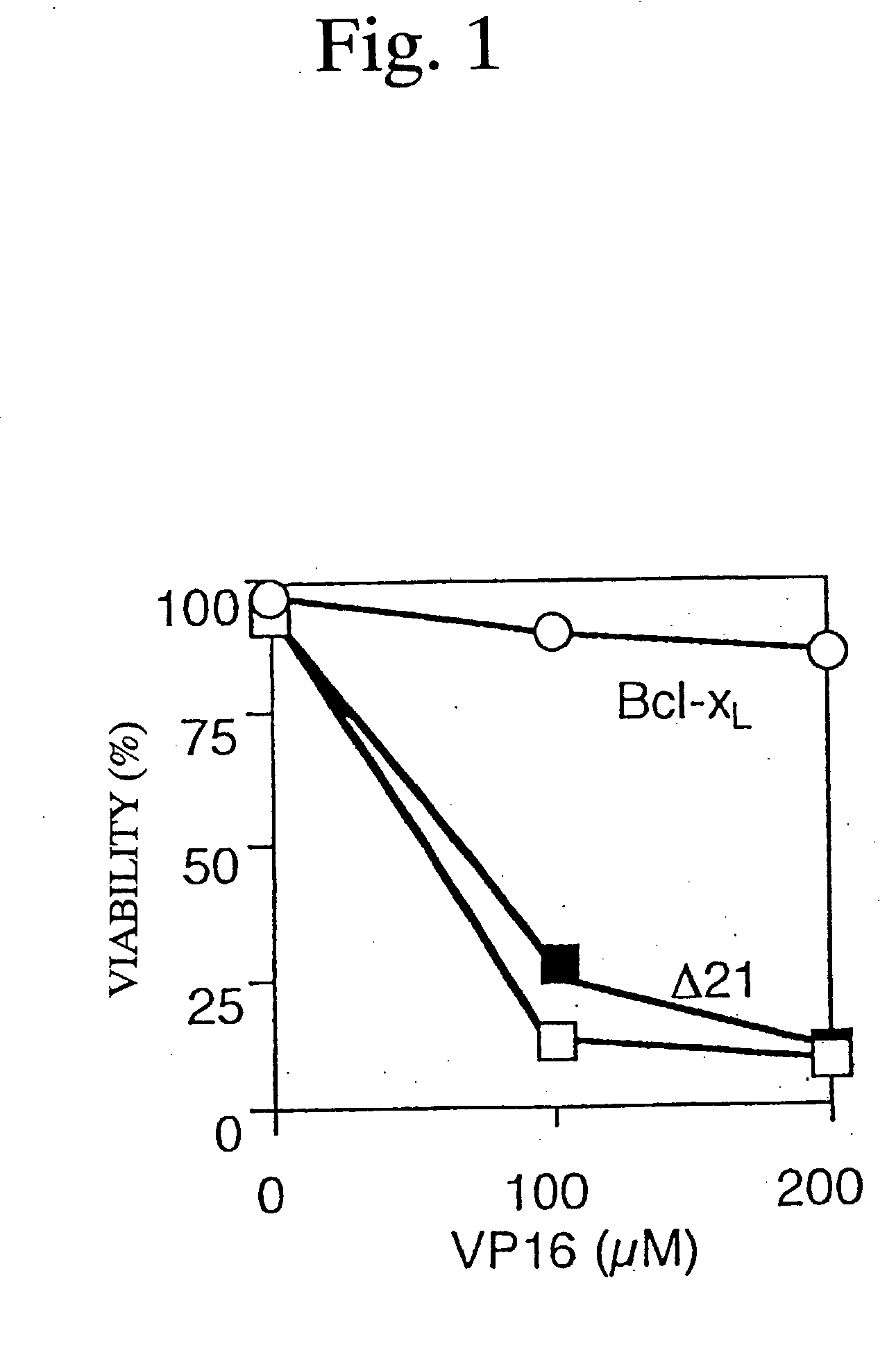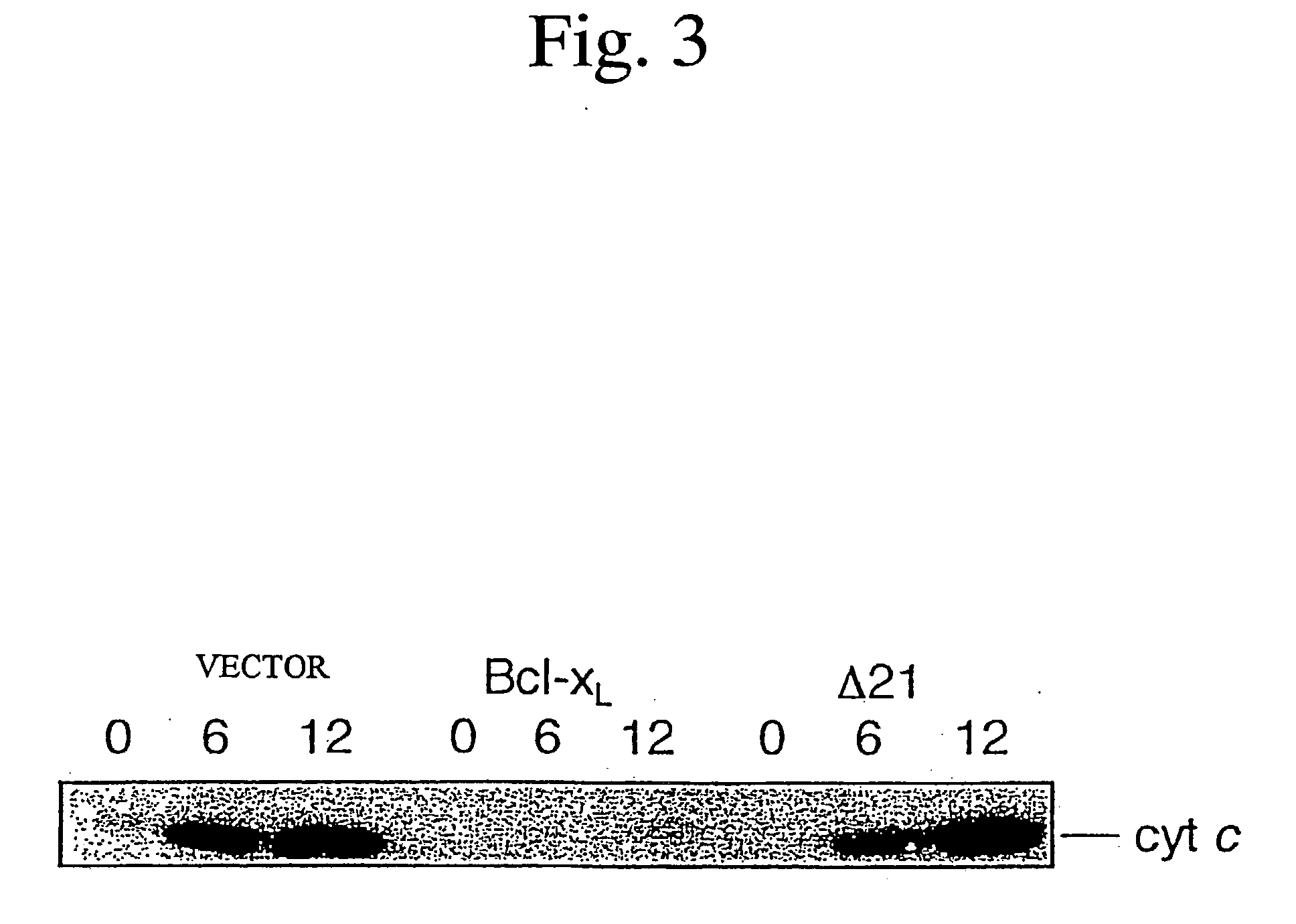Bh4-fused polypeptides
a polypeptide and fusion technology, applied in the field of bh4 fusion polypeptides, can solve the problems of reducing production efficiency, large protein size, and prone to deformation, and achieves the effect of efficient inhibition of apoptosis, excellent characteristic, and suppressing loss and cytochrome c releas
- Summary
- Abstract
- Description
- Claims
- Application Information
AI Technical Summary
Benefits of technology
Problems solved by technology
Method used
Image
Examples
reference example 2
Measurement of Mitochondrial Biochemical Parameters (.DELTA..PSI. and Cytochrome c Release)
[0101] Rat liver mitochondria (1 mg protein / ml) isolated in accordance with a report made by Shimizu et al. [Oncogene, 13, 21-29(1996)] were incubated at 25.degree. C. in a medium containing 0.3 M mannitol, 10 mM HEPES / K.sup.+ (pH 7.4), 0.1% fatty acid-free BSA, 1 mM potassium phosphate, 40 .mu.M CaCl.sub.2 and 4.2 mM succinate for energization in the presence or absence of recombinant proteins.
[0102] .DELTA..PSI. was assessed by measuring the uptake of Rhodamine 123 (Rh123) as previously described by Shimizu et al. [Oncogene, 13, 21-29(1996)].
[0103] The cytochrome c release was evaluated by centrifuging the above-mentioned mitochondria, re-suspending the resulting pellets in an RIPA buffer to give mitochondria suspension, and subjecting the mitochondria suspension and supernatant to Western blot analysis using anti-cytochrome c antibodies.
reference example 3
Immunoprecipitation and Western Blot Analysis
[0104] Purified VDAC (20 .mu.g / ml) was incubated with recombinant BCl-x.sub.L (rBcl-x.sub.L) and recombinant .DELTA.21 (r.DELTA.21), and the resulting mixture was immunoprecipitated with anti-Bcl-x.sub.L (L19) antibody and normal rabbit IgG. In order to detect interactions between polypeptide and VDAC, isolated mitochondria (1 mg) were incubated with 20 .mu.g of Bcl-x.sub.L N-terminal polypeptide or Bcl-x.sub.L C-terminal polypeptide for 5 minutes. Thereafter, the resulting mitochondria were pelleted, washed, and suspended in a lysis buffer (10 mM HEPES, pH 7.4, 142.5 mM KCl, 5 mM MgCl.sub.2, 1 mM EGTA and 0.5% NP40) in the presence of proteinase inhibitors (0.1 mM p-APMSF, 10 .mu.g / ml aprotinin, 1 .mu.g / ml chymostatin, 1 .mu.g / ml leupeptin, 1 .mu.g / ml antipain, 1 .mu.g / ml pepstatin), followed by ultrasonic disruption. Immunoprecipitation was carried out with anti-Bcl-x polyclonal antibodies corresponding to the polypeptides used. Co-immu...
reference example 4
Reconstitution of VDAC in Liposomes
[0105] Purified VDAC was reconstituted in small unilamellar vesicles by the ultrasonic freeze-thaw procedure described in a report made by Shimizu et al. [Nature, 399, 483-487 (1999)]. Sucrose uptake experiment was performed by assessing liposomal swelling.
[0106] Liposomes produced at pH 5.2 were incubated at 25.degree. C. in 1 ml of liposome buffer together with rBcl-x.sub.L, r.DELTA.21, rBax or a polypeptide for 3 minutes. Here, acidic pH was a required condition for efficient uptake of rBcl-x.sub.L and rBax into the liposomes. Thereafter, sucrose was added up to a concentration of 50 mM to the mixture, and the liposomal swelling was assessed by the decrease in light scatter at a wavelength of 520 nm using a spectrophotometer (F-4500, manufactured by Hitachi, Ltd.). Sucrose uptake was also estimated from .sup.14C-sucrose uptake as described in the report made by Shimizu et al. [Nature, 399, 483-487(1999)].
PUM
| Property | Measurement | Unit |
|---|---|---|
| Fraction | aaaaa | aaaaa |
| Fraction | aaaaa | aaaaa |
| Fraction | aaaaa | aaaaa |
Abstract
Description
Claims
Application Information
 Login to View More
Login to View More - R&D
- Intellectual Property
- Life Sciences
- Materials
- Tech Scout
- Unparalleled Data Quality
- Higher Quality Content
- 60% Fewer Hallucinations
Browse by: Latest US Patents, China's latest patents, Technical Efficacy Thesaurus, Application Domain, Technology Topic, Popular Technical Reports.
© 2025 PatSnap. All rights reserved.Legal|Privacy policy|Modern Slavery Act Transparency Statement|Sitemap|About US| Contact US: help@patsnap.com



